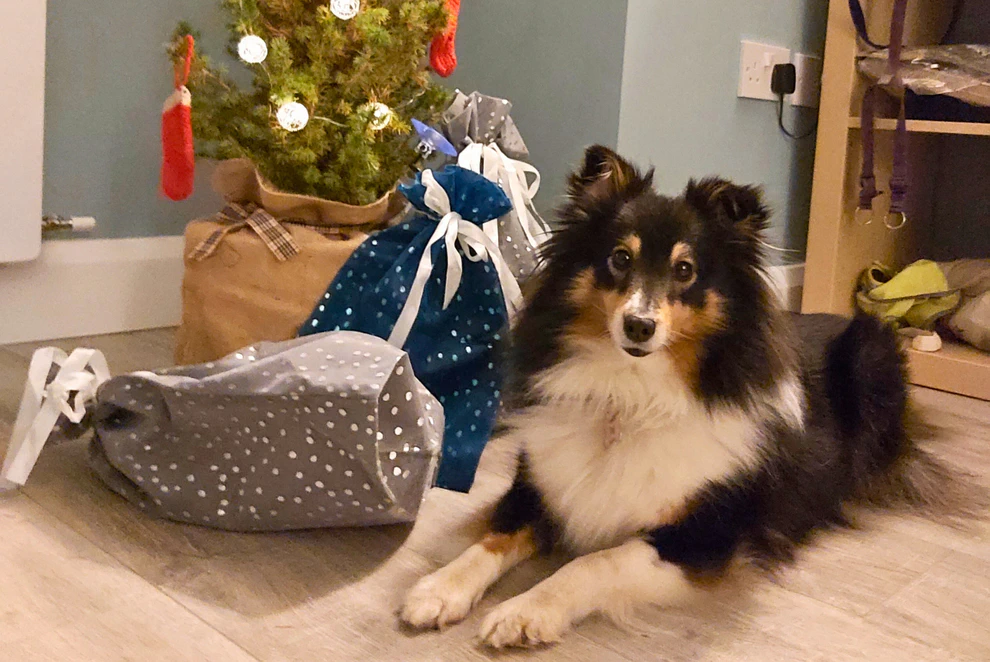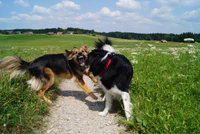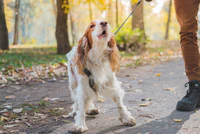The Challenges of Winter for Dogs
Winter brings its own set of unique challenges for our four-legged friends. As the days grow shorter and temperatures plummet, lots of rain in Ireland, the routines that keep dogs physically active and mentally engaged often shift, leading to potential stress and discomfort. It’s essential for dog owners to spot these seasonal challenges and adjust their care routines to ensure their pets remain healthy and happy through the colder months.
One major challenge is the disruption to normal routines. Dogs are highly sensitive to changes in their daily activities, and winter can often force owners to alter schedules or reduce time spent outdoors. This shift can lead to boredom, frustration, and even behavioural issues, as dogs miss out on the exploration and exercise they typically enjoy during warmer months (I am also a fair weather lady!). For active breeds or younger dogs, this change can be particularly unsettling, increasing the need for creative indoor solutions to burn off energy.
Temperature regulation is another significant consideration. While some breeds are naturally equipped to handle cold weather, others—particularly smaller breeds, puppies, and senior dogs—may struggle to stay warm. Exposure to freezing temperatures can pose health risks such as hypothermia or frostbite, especially if dogs are left outside for extended periods without proper protection. Additionally, the dry winter air can lead to skin irritation, while the cold can exacerbate joint pain in older dogs or those with arthritis.
Social interactions can also be affected during the winter. With fewer opportunities for outdoor playdates or visits to the park, dogs may experience reduced socialization, which can lead to feelings of isolation or frustration. Dogs thrive on interaction, whether with their human companions or other canines, and the quieter winter months can sometimes leave them feeling a bit lonely.
Winter-specific hazards further complicate the season. Ice and snow increase the risk of slips and falls, which can result in injuries for both dogs and their owners. Products like antifreeze and road salt, commonly used during icy conditions, are also toxic to dogs if ingested. Even a simple walk in the snow can pose risks, as snow and ice buildup between paw pads can cause discomfort and lead to cracks or injuries if left unchecked.
Oh goodness… lots of winter hazards… to say the least! Don’t worry, this blog has you covered!
Understanding these challenges is the first step toward creating a winter care plan that prioritizes your dog’s well-being. By addressing their physical needs, offering mental stimulation, and being mindful of potential hazards, you can ensure that the colder months remain a joyful and enriching time for both you and your furry friend.
Fun Indoor Activities to Keep Your Dog Moving
When winter weather makes outdoor adventures less appealing, it’s time to get creative with indoor activities that keep your dog both physically active and mentally engaged. Dogs thrive on movement and stimulation, and with a little imagination, you can transform your home into an exciting playground that meets their exercise needs while strengthening your bond.
Interactive Games to Burn Energy
Indoor play doesn’t have to mean missing out on fun. Classic games like tug-of-war can provide an excellent outlet for your dog’s energy. Be sure to set clear rules, such as teaching them to release the toy on command, to keep the game safe and enjoyable. Hide-and-seek is another fantastic option—one person can hide in another room while the dog is encouraged to “find” them, offering an exciting mental and physical challenge. We love this game in our house, find David (who is often behind a door or curtain) us utter fun and our Izzy loves it!
Food-Motivated Fun
Harness your dog’s natural foraging instincts by incorporating food into play. Puzzle toys and treat dispensers are excellent tools for this, offering hours of entertainment while stimulating their problem-solving skills. Scatter feeding is another easy way to keep your dog engaged—sprinkle their kibble around the room or in a safe area and let them sniff it out. You can also create “find it” games by hiding treats in various locations around your home, encouraging your dog to use their nose to track them down.
Training and Tricks for Mental Engagement
Winter is a perfect time to brush up on obedience skills or teach new tricks. Whether it’s mastering “place” training, where your dog learns to settle on a designated mat, or exploring clicker training techniques for more advanced behaviours, these sessions provide essential mental stimulation. Teaching fun commands like “spin” or “high five” can add variety and excitement to your routine, giving your dog something to focus on during those long winter days.
DIY Obstacle Courses for Agility and Fun
Bring the agility course indoors with a creative obstacle setup using household items. Use cushions as hurdles, create tunnels with blankets and chairs, or stack pillows for your dog to climb. Tailor the course to your dog’s size and skill level, and guide them through the course with treats or toys as motivation. Not only does this provide a great workout, but it also strengthens your connection as you work together to complete the course.
Indoor activities can be just as fulfilling as outdoor play when approached with intention and care. By offering a mix of physical exercise and mental challenges, you’ll keep your dog entertained, healthy, and happy, regardless of the weather outside.
Ensuring Safe and Enjoyable Winter Walks for Your Dog
While winter can make outdoor adventures a bit more challenging, daily walks remain an essential part of your dog’s routine. Fresh air, exercise, and exploration are important for both physical health and mental well-being. By taking a few precautions, you can ensure your winter walks are safe, comfortable, and enjoyable for both you and your pup.
Not all dogs are naturally equipped to handle the cold. Breeds with short coats, puppies, and senior dogs may benefit from a well-fitting dog coat or sweater for added warmth. Protect their sensitive paws with dog boots to shield them from ice, snow, and harmful de-icing agents like rock salt. If boots aren’t an option, applying a paw balm can help prevent cracking and dryness.
Adapt Your Walks to the Weather
With shorter days, many winter walks occur during early mornings or evenings when visibility is reduced. Equip your dog with reflective gear, such as a high-visibility leash, harness, or collar. Adding a small LED light to their collar can also improve visibility and ensure your dog is seen by drivers and other pedestrians.
Ice and snow can pose risks, including slips and falls. Pay attention to your walking route and avoid particularly icy areas where you or your dog might lose footing. Additionally, check your dog’s paws for ice buildup or debris after your walk, as these can cause discomfort or injury. Be cautious around antifreeze spills, which are toxic to dogs but can have a tempting sweet taste.
When temperatures drop significantly, shorter, more frequent walks may be safer and more comfortable than long outings. Pay close attention to your dog’s body language—shivering, whining, or lifting their paws frequently can indicate that they’re too cold. On particularly harsh days, supplement outdoor walks with indoor activities to ensure they still get the exercise they need.
Snowy conditions can heighten your dog’s curiosity as new scents and sights emerge. Use a sturdy leash and harness to keep them safely by your side, especially in icy areas where sudden pulling could cause falls. Loose-leash walking skills are especially valuable during winter months to maintain control and avoid mishaps.
Hydration and Nutrition
Even in cold weather, dogs can become dehydrated during physical activity. Bring water for longer walks and make sure your dog has access to fresh water at home. If your dog is more active during the winter, you may also need to adjust their calorie intake to meet increased energy demands.
By preparing for the unique challenges of winter walks, you can ensure they remain a source of joy and enrichment for your dog. With the right gear, safety precautions, and a little extra care, your pup can enjoy exploring the winter wonderland while staying healthy and happy.
Dog-Friendly Festive Tips for Christmas
The holiday season brings excitement, gatherings, and a host of new sights and smells—but for dogs, it can also introduce stress and potential hazards. Ensuring your home and celebrations are dog-friendly is key to creating a safe and enjoyable environment for your furry companion during Christmas.
Festive decorations can be intriguing for curious dogs but also potentially dangerous. Keep fragile ornaments, tinsel, and electrical cords out of reach to prevent accidental ingestion or injury. Opt for dog-safe decorations like shatterproof ornaments and secure your Christmas tree to prevent it from tipping over. Avoid using toxic plants such as poinsettias, mistletoe, and holly in your decor, as these can be harmful if ingested.
Many holiday treats and meals contain ingredients that are unsafe for dogs. Chocolate, raisins, grapes, and fatty leftovers can cause serious health issues if consumed. Instead, include your dog in the festivities with pet-safe treats or a small portion of plain, cooked meat. Keep food out of reach and remind guests to avoid sneaking your dog harmful human snacks.
With visitors and increased activity, the festive season can be overwhelming for some dogs. Set up a “safe zone” in a quiet area of your home where your dog can retreat if they feel stressed. Equip this space with familiar bedding, favorite toys, and calming aids like a pheromone diffuser or soothing music. Teach your dog to associate this area with positive experiences so they see it as a haven.
If you’re hosting guests, communicate your dog’s needs and boundaries in advance. Encourage visitors to greet your dog calmly and respect their space, especially if your dog is shy or reactive. If your dog becomes excited or nervous around new people, use treats and training cues to redirect their focus.
Let your dog share in the joy of the season with activities tailored to their needs. Dress them in a festive bandana or holiday sweater (if they’re comfortable wearing clothing) for family photos. Prepare a dog-friendly stocking filled with safe toys and treats, or include them in a gift exchange by letting them “unwrap” their presents under supervision.
Despite the busy season, try to stick to your dog’s regular routine for meals, walks, and playtime. Predictability helps reduce anxiety and ensures your dog feels secure amidst the holiday excitement.
If your plans include traveling, ensure your dog is comfortable with the journey or arrangements for their care. Whether you’re boarding them or bringing them along, prioritize their safety and comfort.
By incorporating these tips, you can celebrate the season while keeping your dog safe, happy, and included in the festivities. With thoughtful preparation, Christmas can be a time of joy and connection for the entire family—including your beloved pup.
Wrapping Up: A Season of Joy for Your Four-Legged Friend
The holiday season is a time to celebrate, reflect, and cherish the moments we share with loved ones—including our dogs. While the colder months and festive hustle bring unique challenges, they also offer countless opportunities to deepen your bond with your furry companion.
By addressing your dog’s physical and mental needs through creative indoor activities, ensuring safe winter walks, and planning a dog-friendly festive environment, you’re not just keeping them healthy—you’re making them a true part of your holiday celebrations. Small acts of care, like preparing a cozy retreat or including them in family traditions, can go a long way in showing your love and appreciation for the joy they bring to your life year-round.
This Christmas, let your dog be part of the magic. Whether it’s a wagging tail during a game of hide-and-seek, a peaceful nap in a warm, safe spot, or the excitement of unwrapping a new toy, these moments remind us of the simple yet profound happiness our pets bring.
Take this opportunity to make their season as special as they make yours. And as you plan for the festivities, don’t forget to explore helpful resources, from dog-friendly holiday tips to thoughtfully crafted products that prioritize their comfort and well-being.
Here’s to a winter filled with love, warmth, and wagging tails. Happy holidays from your entire pack to ours! Bright Horse Tack & Tails




